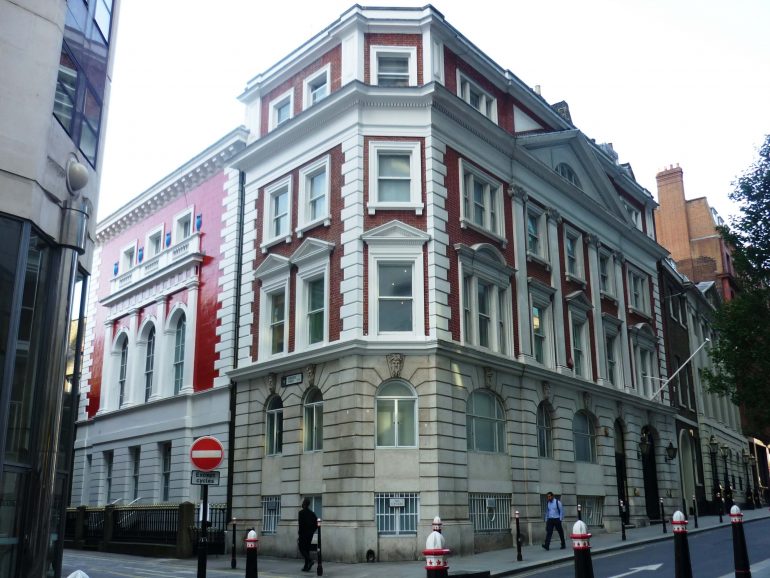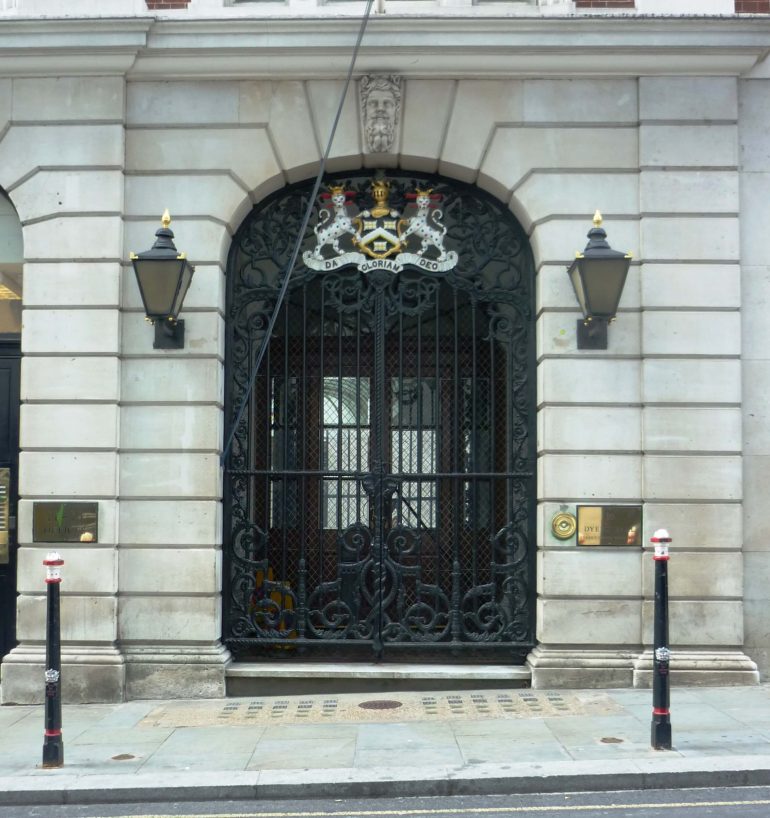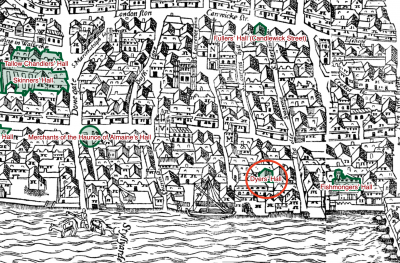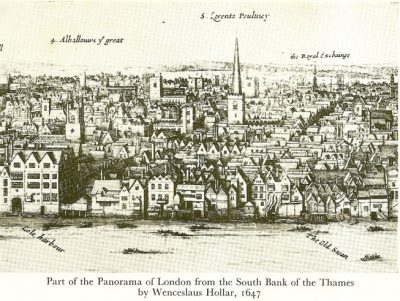First Dyers’ Hall destroyed by The Great Fire
The First Dyers Hall at Three Stars was destroyed by The Great fire in 1666. The Fire of London began at night on the 1st September no more than 200m from the Three Stars site. By the evening of the next day, both the Dyers’ Hall and the Dowgate property were completely destroyed. There is no record of how individual dyers or Company officials responded to the crisis as it unfolded but someone certainly was concerned; some records and the beautiful charters survived: perhaps as much as could be hurriedly stuffed into a bag.
Any temptation to condemn the senior members of the Company for not doing more should be resisted. Dyers Hall in 1666 was down by the river and close to the ‘true heart of the fire’, on Thames Street. Samuel Pepys awoke at 7am on the 2nd September, the Lords Day, and after various consultations and observations took to the river. The Fire had already reached the Old Swan and travelled very fast along the riverbank, reaching the Steelyard (next to Cannon Street) in under an hour.
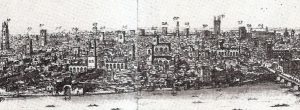
After the Fire by Holler
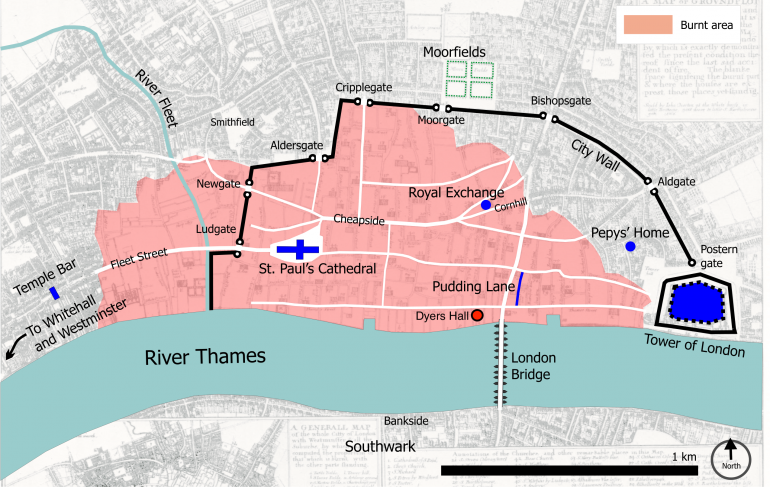
Map of The Fire of London 1666
Second Dyers’ Hall destroyed by Fire
After The Great Fire of 1666 Dyers’ Hall was rebuilt on the same site. The Ogilby and Morgan map of 1676 clearly shows the now, neater arrangement of Three Stars or Dyers’ Hall as it was commonly known, stretching from Thames Street (Lower Thames St) to The Thames with direct access to Dyers Hall Wharf.
The Company also owned land at DowGate and in 1669 they leased part to John Sawyer, ‘citizen and sadler of London’, ‘a toft whereupon a tenement was heretofore erected which was lately burned down by the late fire’. The lease was for 60 years and ‘for the time being’ the rent was £6. Sawyer was ‘in twelve months in truly workmanlike manner, to erect one strong substantial sufficient handsome and convenient new dwelling house with so many cellars storeys and garrets and built with such brick stone etc and contain such heights scantlings thickness and other dimensions with such pipes gutters set up the arms of the Wardens carved in Portland stone etc as mentioned for houses to be fronting streets and lanes of note according to the late act for the rebuilding of the City of London’. The lease was to expire in 1729.
Just as the Company became reorganised, the second Dyers’ Hall at Three Stars burnt down again, in another fire, a few years later in 1681.
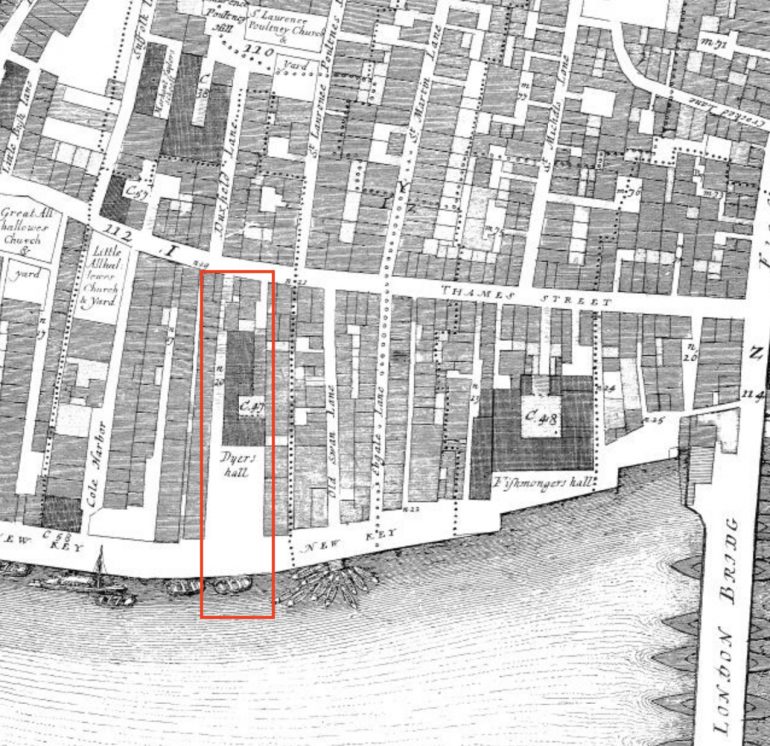
The Ogilby and Morgan map of 1676
The Dyers’ Company Move to Dowgate Hill
Following the destruction of the second Hall, The Dyers’ Company was running low on cash reserves and in 1682 decided not to rebuild on the Three Stars site, as it could provide a good income given the proximity to the River and Workhouses of Industry. Instead, The Company chose to maximise its income from both this and the Dowgate Hill Site and wait until the leases expired in 1731.
In 1731 The Company occupied part of the Dowgate Site on Elbow Lane (College St) and used this as The Court Room.
In 1768 The Court Room collapsed.

Third Dyers’ Hall on Dowgate Hill
In 1768 with funds raised from some good investments and new benefactors, The Dyers set about building a new Hall. The Hall was completed in 1770 and fronted on to Elbow Lane (College Street) on the site of the previous Court Room.
By 1826 the question of repairing or rebuilding the Hall was under discussion. The Court decided to repair the Hall, though a firm of builders quoted £6,515 10s to rebuild it or ‘in a more superb manner’ for £7,125 10s.
In any event the Hall became unsafe and had to be demolished in 1838.
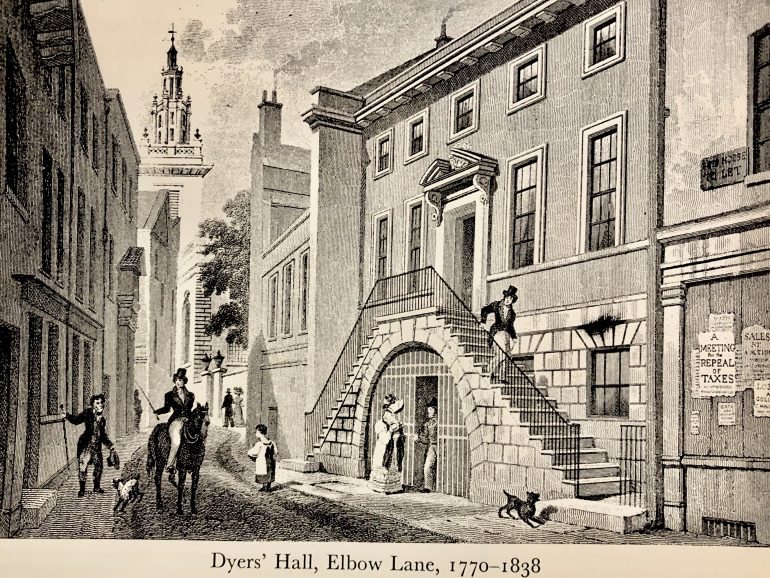
The Fourth Dyers’ Hall
Designed by Charles Dyer and bult in 1839-41, the current Hall is listed Grade II* and is a Scheduled Ancient Monument.
Most people imagine that this building, fronting onto Dowgate Hill, is Dyers’ Hall – in fact the Hall is the building behind and the Court Room occupies the same space as the previous Hall – which you can see on the left hand side of the picture.
The front block contains the Company’s offices. It was built in 1856 in the Palladian style, comprising four storeys, basement and dormers. Originally designed as two houses (11 & 12) and The Bunch of Grapes public house (no 13) the building underwent a radical redesign in 1936 with the insertion of a raised ground floor and the incorporation of the three properties into one.
The raised ground floor has four windows to the Dowgate Hill frontage, one on a canted corner and two facing College Lane. An order of four Ionic pilasters to the first and second storeys support a pediment with lunette.
The College Street frontage included the original main entrance, and has a stuccoed elevation of three storeys with five windows to the channelled ground storey and three to each storey above. The first floor windows, of which the central one is dummy, are framed by Doric pilasters topped with urns and balustrade beneath square windows.
The current main entrance is on Dowgate Hill, with handsome cast iron gates decorated at the top with the painted arms of the Company enclosing a vaulted passage partly floored with decorative tiles including the arms of the Company.
Dyers’ Hall is undergoing phased programmes of major refurbishment.
The history of Dyers Hall was revised in 2008 by Tony Dyson and Ian Mackintosh (The Company’s Archivist).
Download the PDF file below for The Origins of Dyers Hall.
Download the PDF file below for The Origins of the Dowgate Hill site.
Download the PDF file below for the story of The Great Fire and The Dyers Company
